Lisbon Sightseeing

Cristo Rei
(Catch the ferry to Cacilhas from Cais do Sobre then grab Bus 101 (€1.35 return)), [9]. 9AM - 6PM. Similar to the Christ statue in Rio de Janeiro, this statue stands over 100 meters tall on the opposite bank of the Tejo River from downtown Lisbon. Views from the top of the statue are breathtaking, although the elevator up will cost you €5. 5 €.
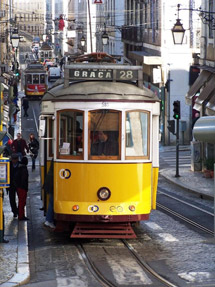
Specialty transport
Tram 28. Instead of paying for a ride on one of the costly tourist trams, try Tram 28. Tram (or "Eléctrico" in the Portuguese) Line 28 is one of only three traditional tram lines that still operate in Lisbon. These trams, which until the late-1980's ran all through-out Lisbon, were manufactured between 1936 and 1947. Tram 28 winds its way through the "Old Town" of Lisbon (dating from the 17th century) beginning in Graça then down to the Alfama and to the Baixa then up through Chiado to Bairro Alto and then down to Campo Ourique, taking you by many of Lisbon's most famous and interesting sites including monuments, churches and gardens. The trip is hilly, noisy and hectic but it affords many beautiful glimpses of the city. And, although the tram can sometimes be overrun with tourists, you will definitely get a flavor of the locals, as many "Lisboetas" commute daily on these historical trams. Tickets cost €1.45 per journey and can be purchased on-board at a vending machine (note that these machines do not accept notes, and are sometime even out of change, so make sure you have the correct change!) From start to finish the ride takes around 30 minutes. Beware of pickpockets.
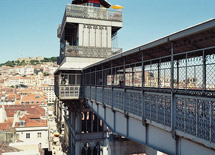
Funiculars
Santa Justa's Elevator, Rua Aurea & Rua de Santa Justa, +351 (21) 361-3054. Located downtown, this elevator was designed by a follower of French engineer Gustav Eiffel and connects the downtown to the Trindade, located several meters uphill. 7 Colinas valid.
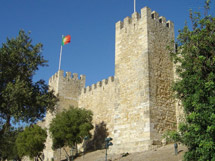
Architecture
Castelo de São Jorge (St. George's Castle), (Walk up the hill from Alfama or take bus 37), +351 218 800 620. 9AM - 9PM (March - Oct) and 9AM-6PM (Nov-Feb). Located up the hill, with a great view over the city and the river. If you have the energy, get there by walking from downtown, going through the fantastic old neighborhood of Alfama. €7 with student discount available.
Aqueduto das Aguas Livres. This is a historic aqueduct in the city of Lisbon, Portugal. It is one of the most remarkable examples of 18th-century Portuguese engineering. The main course of the aqueduct covers 18 km, but the whole network of canals extends through nearly 58 km. The Mãe d'Água (Mother of the Water) reservoir of the Amoreiras, the largest of the water reservoirs, was finished in 1834. This reservoir, with a capacity of 5,500 m³ of water, was designed by Carlos Mardel. It is now deactivated and can be visited as part of the Museu da Água (Water Museum).
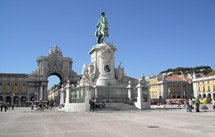
Neighbourhoods
Chiado. Take a stroll along the historical streets of this elegant shopping district, stopping for a cup of coffee with the statue of Fernando Pessoa, Portugal's great Modernist poet. Head uphill to Bairro Alto, for stunning views of the city and some wild partying in Lisbon's most popular nightclub district.
Downtown (Baixa). This part of the city was completely rebuilt after the 1755 earthquake by the Marquis de Pombal. The planned layout, greatly different from what you will see in the more ancient neighborhoods, is a testimony to the ideas of the Enlightenment.
Alfama. This neighborhood still bears signs of the Moorish presence in the city, with the buildings very close to each other, and very irregular streets. It's very atmospheric and a great spot in which to wander around.
Praça do Comércio, (Take the metro to Terreiro do Paço Station). This magnificent plaza, facing the river, is the beginning of Lisboa's downtown. It is also known as 'Terreiro do Paço', meaning 'Grounds of the Palace', relating to its function before the Great Earthquake of 1755.
Belém. This monument-packed neighborhood is a must-see place. Take tram 15 to the west, which follows the coast line. Check the route map inside the tram: it helps to find a right station for most famous of Belém attractions. Or take the Cascais suburban train (line "Cascais todos"; the express trains don't stop in Belém) to Belém and walk to the attractions. The extensive bus network also serves Belém from various departure points around the city and can be less busy than the tram.
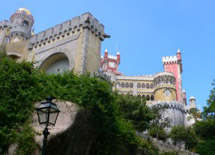
Sintra
Sintra is both a town and a municipality in the Lisbon Coast/aka Estoril Coast region of Portugal. Its spectacular setting, 28km from Lisbon, houses a Royal Palace, used by generations of Portuguese royalty prior to the 1910 revolution. The surrounding hills are surmounted by the remains of the Moorish Castle and by the nineteenth-century Pena Palace. Historic Sintra is an heritage patrimony sight declared by UNESCO. The Estoril coast is often considered to be part of the Lisbon coast, which includes Cascais, Lisbon, Sintra, and other nearby municipalities.
Near Estoril, the majestic Sintra Mountains cast a veil of mystery over the town nestling on its northern slopes. The hills and the surrounding area have been classified by UNESCO as a World Heritage site both for their cultural significance and for their outstanding natural beauty.
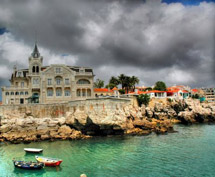
Cascais
Cascais is a small beach town in Portugal next to Estoril coast in the greater Lisbon area. Cascais, former residence of the royal family and pioneer of tourism in Portugal, is a very charming village. Dominated by the bay and the imposing Cidadela fort, the historic centre is brimming with architectural treasures of a religious, military and civil nature. Likewise, the museums of the Sea, Casa das Histórias de Paula Rego, and the Municipal Museum Condes de Castro Guimarães are also must-see attractions.
